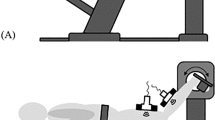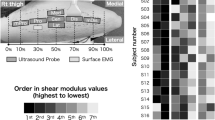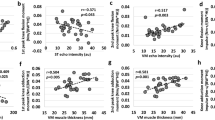Summary
The physiological cross-sectional areas (CSAp) of the vastus lateralis (VL), vastus intermedius (VI), vastus medialis (VM) and rectus femoris (RF) were obtained, in vivo, from the reconstructed muscle volumes, angles of pennation and distance between tendons of six healthy male volunteers by nuclear magnetic resonance imaging (MRI). In all subjects, the isometric maximum voluntary contraction strength (MVC) was measured at the optimum angle at which peak force occurred. The MVC developed at the ankle was 746.0 (SD 141.8) N and its tendon component (F t) given by a mechanical advantage of 0.117 (SD 0.010), was 6.367 (SD 1.113) kN. To calculate the force acting along the fibres (F f) of each muscle, F t was divided by the cosine of the angle of pennation and multiplied for (CSAp · ΣCSAp−1), where ΣCSAp was the sum of CSAp of the four muscles. The resulting F f values of VL, VI, VM and RF were: 1.452 (SD 0.531) kN, 1.997 (SD 0.187) kN, 1.914 (SD 0.827) kN, and 1.601 (SD 0.306) kN, respectively. The stress of each muscle was obtained by dividing these forces for the respective CSAp which was: 6.24 × 10−3 (SD 2.54 × 10−3) m2 for VL, 8.35 × 10−3 (SD 1.17 × 10−3) m2 for VI, 6.80 × 10−3 (SD 2.66 × 10−3) m2 for VM and 6.62 × 10−3 (SD 1.21 × 10−3) m2 for RE The mean value of stress of VL, VI, VM and RF was 250 (SD 19) kN m2; this value is in good agreement with data on animal muscle and those on human parallel-fibred muscle.
Similar content being viewed by others
References
Alexander RMcN, Vernon A (1975) The dimensions of knee and ankle muscles and the forces they exert. J Hum Mov Stud 1:115–123
Close RI (1972) Dynamic properties of mammalian skeletal muscles. Physiol Rev 52:129–197
Edgerton VR, Roy RR, Apor P (1986) Specific tension of human elbow flexor muscles. In: Saltin B (ed) Biochemistry of exercise: VI. Int Series Sport Sci 16:487–499
Fick R (1910) Handbuch der Anatomie und Mechanik der Gelenke unter Berücksichtigung der bewegenden Muskeln. Fischer, Jena
Friederich JA, Brand RA (1990) Muscle fibre architecture in the human lower limb. J Biomech 23:91–95
Giannini F, Landoni L, Merella N, Minetti AE, Narici MV (1990) Estimation of specific tension of human knee extensor muscles from in vivo physiological CSA and strength measurements. J Physiol (Lond) 423:86P
Grindrod S, Round JM, Rutherford OM (1987) Type 2 fibre composition and force per cross-sectional area in the human quadriceps. J Physiol (Lond) 390:154P
Haxton HA (1944) Absolute muscle force in the ankle flexors of man. J Physiol (Lond) 103:267–273
Henriksson-Larsén K, Wreling ML, Lorentzon R, Öberg L (1992) Do muscle fibre size and fibre angulation correlate in pennated human muscles? Eur J Appl Physiol 64:68–72
Lieb FJ, Perry J (1968) Quadriceps function. An anatomical and mechanical study using amputated limbs. J Bone Joint Surg 50:1535–1548
Maughan RJ, Nimmo MA (1984) The influence of variations in muscle fibre composition on muscle strength and cross-sectional area in untrained males. J Physiol (Lond) 351:299–311
Narici MV, Roi GS, Landoni L (1988) Force of knee extensor and flexor muscles and cross-sectional area determined by nuclear magnetic resonance imaging. Eur J Appl Physiol 57:39–44
Narici MV, Roi GS, Landoni L, Minetti AE, Cerretelli P (1989) Changes in force, cross-sectional area and neural activation during strength training and detraining of the human quadriceps. Eur J Appl Physiol 59:310–319
Nygaard E, Houston M, Suzuki Y, Jorgensen K, Saltin B (1983) Morphology of the brachial biceps muscle and elbow flexion in man. Acta Physiol Scand 117:287–292
Ralston HJ, Polissar MG, Inman VT, Close JR, Feinstein B (1949) Dynamic features of human isolated voluntary muscle in isometric and free contractions. J Appl Physiol 1:526–533
Reid JG, Costigan PA (1985) Geometry of adult rectus abdominis and erector spinae muscles. J Orthop Sports Phys Ther 5:278–280
Rutherford OM (1986) The determinants of human muscle strength and the effects of different high resistance training regimes. PhD thesis, University of London
Rutherford OM, Jones DA (1992) Measurement of fibre pennation using ultrasound in the human quadriceps in vivo. Eur J Appl Physiol 65:433–437
Sexton AW, Gersten JW (1967) Isometric tension differences in fibres of red and white muscles. Science 157:199
Smidt GL (1973) Biomechanical analysis of knee flexion and extension. J Biomech 6:79–92
Weber E (1846) Wagner's Handworterbuch der Physiologie. Vieweg, Braunschweig
Wickiewicz TL, Roy RR, Powell PL, Edgerton VR (1983) Muscle fibre architecture of the human lower limb. Clin Orthop 179:275–283
Winter EM, Maughan RJ (1991) Strength and cross-sectional area of the quadriceps in men and women. Proceedings of the Physiological Society, University College London meeting, March, 59P
Yamaguchi GT, Sawa AGU, Moran DW, Fessler MJ, Winters JM (1990) A survey of human muscolotendon actuator parameters. In: Winters JM, Woo SL-Y (eds) Multiple muscle systems: biomechanics and movement organization. Springer, New York Berlin Heidelberg, pp 717–773
Young A (1984) The relative strength of type I and type II muscle fibres in the human quadriceps. Clin Physiol 4:23–32
Author information
Authors and Affiliations
Rights and permissions
About this article
Cite this article
Narici, M.V., Landoni, L. & Minetti, A.E. Assessment of human knee extensor muscles stress from in vivo physiological cross-sectional area and strength measurements. Europ. J. Appl. Physiol. 65, 438–444 (1992). https://doi.org/10.1007/BF00243511
Accepted:
Issue Date:
DOI: https://doi.org/10.1007/BF00243511




